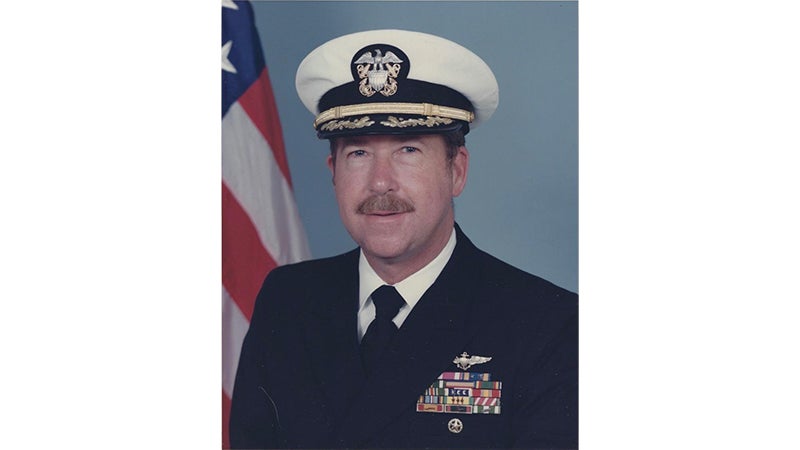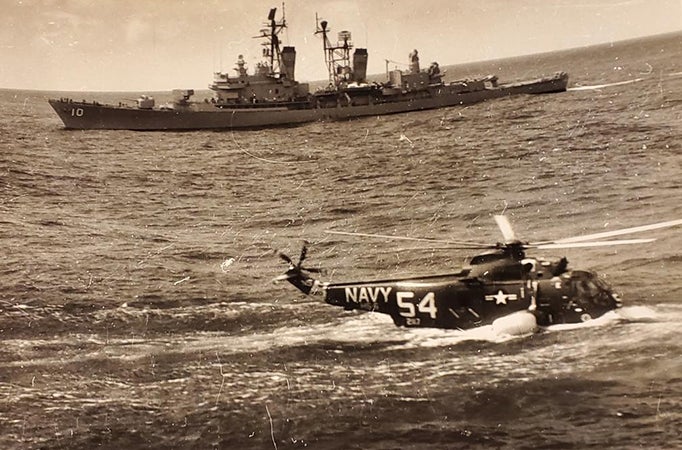Raymond M. “Buck” Carlton Jr., Captain, U.S. Navy, Helicopter pilot, Vietnam War – Part 1
Published 1:30 pm Friday, March 17, 2023

- Captain Raymond M. "Buck" Carlton, Jr., U.S.Navy, Commanding Officer, Helicopter Minesweeping Squadron 16 [HM-16]. [Photo: Buck Carlton]
|
Getting your Trinity Audio player ready...
|
According to Buck Carlton, there is no way he and his younger brother, Bob, could not have become involved in aviation. Buck recalled, “When we visited my grand-parents’ home in Andalusia, Alabama, we slept upstairs in ‘The Boy’s Room,’ where my Uncles Max and Billy Avant had slept when they grew up. That room was our introduction to aviation. To say that our two uncles were crazy about airplanes and aviation would be an understatement.
“Maybe it was the ‘Lindberg Effect,’ the excitement created by Lindberg’s famous flight across the Atlantic in 1927…As you walked into that room, there were model planes, decorated with the typical Army Air Corps’ blue fuselage and yellow wings, hanging from the ceiling. There were pictures of the latest fighter planes like the Curtiss P-40 ‘Warhawk’ and the Lockheed P-38 ‘Lightning’ as well as photos of the brothers’ visit to Eglin Field in nearby northwest Florida.
“There was a WW II Aircraft Observer Arm Band from Uncle Max’s duty as an ‘Aircraft Observer’ hanging from the mantle indicating that he and fellow observers, Jack Pippin and Carlos Padget had called in their observation of military aircraft over Andalusia…Bob and I were immersed in aviation and I think that early indoctrination stuck.”
Raymond Mondelle “Buck” Carlton, Jr. was born August 8, 1940, in Gadsden, Alabama. His parents were Raymond M. Carlton, Sr. and Celeste Avant Carlton. The father was an Alabama Highway Patrolman. In December 1943, Buck’s father was drafted into the Navy. He served as a Shore Patrol officer at the Great Lakes Naval Training Center until December 1947, when he was discharged. He rejoined the state troopers and moved the family to Luverne, Alabama.

Photo of April 12, 1966 incident showing LTJG Buck Carlton’s SH-3 helicopter taxiing with flotation bags deployed. Shortly after this photo was taken, a large wave caused the helicopter rotors to strike the water, making the helicopter roll over, turning it upside down. Carlton, LCDR Zidbeck [the pilot] and two sonar crewmen escaped and were picked up by a motor whale boat from the destroyer USS King [DLG-10], shown in the background. [Photo: Buck Carlton]
Buck entered the Naval Aviation Officer course at Naval Air Station, Pensacola, Florida, on July 21. He received his commission as an Ensign in the Navy on the day of President Kennedy’s assassination, November 22, 1963. Following that, he entered flight training in fixed-wing aircraft. After carrier qualifying aboard the USS Lexington [CV-11], Buck was sent to Naval Air Station Ellyson Field in Pensacola to qualify in rotary-wing aircraft [helicopters]. He received his Wings on March 15, 1965.
In May 1965, Buck was sent to Navy Outlying Landing Field [NOLF], Ream Field, Imperial Beach, California, and assigned to Helicopter Anti-submarine Squadron 10 [HS-10]. For the next four months, he learned to fly the Sikorsky SH-3A helicopter. In September, he was assigned to Helicopter Anti-Submarine Squadron 6 [HS-6] where he trained to be a copilot. Training continued for several months. Buck qualified as a copilot prior to the incident in April 1966.
On the morning of April 12, 1966, the USS Kearsarge [CVS-33] departed the port of San Diego for a routine, two-week anti-submarine warfare [ASW] training exercise. As a defensive procedure, two SH-3 helicopters from Helicopter Anti-Submarine Squadron 6 [HS-6] went ahead some eight-to-ten miles to screen for submarines. Onboard one of the helicopters [Bureau # 152117] was the pilot, LCDR. Bill Zidbeck, copilot, LTJG. Buck Carlton and two sonar crewmen.
The SH-3 is powered by two General Electric T-58 gas turbine engines. It has a boat-shaped hull with outrigger sponsons, which house the main landing gear and emergency flotation bags. It carried a “dipping sonar” which was used to search for submarines. Normal procedure requires the helicopter to hover at 40 feet, then lower the sonar dome into the water and commence a search. Sonar [sound navigation and ranging] sends out a pulse that, when reflected from a submarine, gives distance and direction.
After some eight-to-ten minutes of searching, the sonar dome is raised and a new search started at a new location. Zidbeck had completed several “searches,” then turned over the controls over to Buck Carlton. Carlton recalled, “I had started my second search when the number one engine suddenly quit [flamed out] and we quickly settled into the water. Once we were in the water, Bill took over the controls and had me deploy flotation bags on either side of the sponsons.
“Our number two engine was still working, driving the main transmission and hydraulics. The main rotor and tail rotor blades were still turning, the hydraulic pumps were still boosting the flight controls and the generators were online…We were in good shape!
“Bill asked me to re-start number one engine. After I got the engine going, it began coming up to speed, but then I got an ‘ENGINE FIRE LIGHT.’…I shut the engine down and pulled the ‘Fire T Handle,’ which fired fire extinguisher foam into the engine… The fire was out and we were still running on engine number two…The configuration of the SH-3 allows the pilot to ‘water-taxi,’ so Bill decided to try and make it back to NAS North Island, about 10 miles away.”
One of the problems with water taxiing is the intake of water through the hole in the bottom of the helicopter that allows the sonar dome to be deployed or retracted during ASW dipping operations. Carlton recalled, “As we taxied, the force of the sea swells caused water to flood up through the opening. Although our sonar crewmen had stuffed internal sound proofing material in the hole, we were still taking on water and within 15 to 20 minutes, we had about six inches of water on the floor of the helicopter. Pretty soon, the water had shorted out the electrical system causing us to lose the UHF radio and the intercom system. Bill and I had to yell to each other to be heard.
“My side window was open and as a large swell would approach, I would shout to Bill who would then ease off on the flight controls. The closer we got to the shore, the bigger the swells became. I saw a really big swell approaching and told Bill, ‘here comes a big one!’…Suddenly, the helicopter rose up and pitched forward, causing the helicopter’s main rotor blades to strike the water. That caused us to roll over on the right side, then suddenly we were upside down. The main rotor blades had struck the rear part of the fuselage, severing the tail pylon and tail rotor system.
“Once we were upside down, my training reflexes kicked in. I disconnected the cord to my flight helmet, released my shoulder harness, slid out through the side window and swam to the surface. Bill did the same thing and exited through the right window. The two sonar crewmen exited through the left door. We made it to the surface and Bill got us all accounted for.”
A nearby Navy destroyer, the USS King [DLG-10], had observed the rollover and promptly dispatched a motor whale boat to pick up the men. Carlton recalled, “They took us to the pier at North Island where we were then taken to the North Island Hospital to be out checked out by a doctor. We were OK and pretty soon, we were headed back to the Kearsarge on board one of our own SH-3As.” [End Part 1]
John Vick




